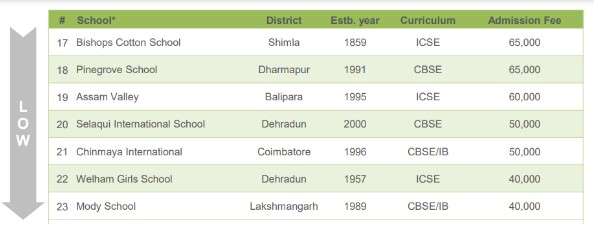Best International Boarding Schools in India: You won’t believe their fees!

Indian parents spend nearly 5 – 6 lakhs every year on their child’s education. The emergence of nuclear families flared up the importance, of working partners, and the race for proving the best opportunity for your child has increased the demand for international boarding schools in India.
If you are a parent struggling to decide the best school for your child then let’s examine some pros and cons of international boarding schools in India!
Best International Boarding Schools
Here is a list of the best international boarding schools found across India:
- Oakridge International School, Visakhapatnam
- Cambridge School Srinivaspuri, New Delhi
- Chinmaya International Residential School, Coimbatore
- Good Shepherd International School, Ooty
- The Doon School, Dehradun
- Ecole Globale International Girls’ School, Dehradun
- G. D. Birla Memorial School, Ranikhet
- Manava Bharati India International School, Mussoorie
Pros of boarding school
1. Multidisciplinary Perspective
The development of a student’s personality is significantly influenced by boarding schools. Students are instilled with a feeling of accountability and a sense of discipline and timeliness.
This is advantageous not just in academics but also in all facets of daily life. Children’s real-life lessons in such schools provide a firm basis for their maturity.
2. Improved living standard
Children studying and staying in boarding schools are maintained at a shoulder-level distance from late-night partying and all other bad habits, which may be extremely easy for children who attend day school.
As a result, it becomes easy to argue that boarding schools provide a better way of life.
3. Building assertiveness and confidence
Performing regular chores, such as arranging school supplies, preparing their bedding, tidying up their room, and many other minor duties, provides assurance and instills confidence in the youngsters. Students become more self-assured and competent.
4. Independence
Money and time management are two of the primary benefits of attending a boarding school. Living apart from home teaches children not to overspend and to save money for worthwhile things. They even become good at managing decision-makers on their own.

Sending Child to International Boarding School
Cons of boarding school
1. Yearning for Home
While the children have many similarities, there is no arguing that they’ll miss their friends and families. It is common among children who live and study in boarding schools.
It is common for boarders to experience depression as they struggle to overcome their homesickness. The first few months of boarding can be difficult for most of them.
2. Fees for boarding schools
The vital requirement for fees by most boarding schools in India is one of the essential factors for all parents. People believe that the fees will put a dent in their finances.
At one of the costliest boarding schools in India, you can expect to pay between Rs. 14,50,000 and Rs. 16,70,000 a year for your child’s education.
The annual fees for such top international boarding schools in India exceed ten lakh rupees.
3. No distinction between school and leisure
Children should know once school is finished and could perhaps concentrate on having fun outdoors and other activities rather than staying on campus all day. In the long run, this may be harmful to children.
4. Difficulties finding friends
Finding friends outside of boarding school can be difficult. Although the children in boarding schools almost always form great friendships and companionship, those children will have practically no friends beyond the boarding school because they stay on campus and won’t be permitted to leave it very often.
What is the cost of studying in international boarding schools in India?
There are three main tuition fees to look for: annual recurring fees, admission fees, and security fees.
Let’s look at the annual recurring fees for international boarding schools. Significant institutions are classified into three major segments:
- High Fee: Rs. 9,00,000
- Affordability Fee: Rs. 4,00,000 – 9,00,000
- Low Fee: Rs. 4,00,000


The admission fee structure in boarding schools!
Based on admission fees, the top institutions are classified into three major segments:
- High Fee: Rs. 1,50,000
- Affordability Fee: Rs. 100,000 – 1,50,000
- Low Fee: Rs. 1,00,000


The security fee structure in boarding schools!
Based on security fees, the top institutions are classified into three major segments:
- High Fee: Rs. 3,00,000
- Affordability Fee: Rs. 1,00,000 – 3,00,000
- Low Fee: Rs. 1,00,000


How much would you need to save every year for a child’s education?
After accounting for a 12% increase in annual tuition prices, the average totals 14 lakh or higher. You must save 4.5 lakh per year for your child’s education.
International boarding schools provide a solid basis for developing a confident and unique personality. Parents may spend anywhere between 3-5 lakhs per annum on school fees alone.
With an ever-rising school fee, an expert’s assistance can help invest from the toddler years. It is the best way to plan education expenses.
FAQs
What are the fees for international boarding schools in India?
The annual fees for international boarding schools in India start at INR 4,00,000 to INR 9,00,000.
Which country is best for boarding school?
Switzerland is home to some of the best boarding schools in the world. The international elite and the royal kids often study at schools like St. George’s International School and Collège Alpin International Beau Soleil which are located in Switzerland. The boarding fee for St. George’s International School is $73,850!
Which is the No. 1 international school in India?
- Here are the top 5 International Schools in India 2023-24:
- Dhirubhai Ambani International School.
- Ecole Globale International School.
- Doon School.
- Amity International School.
- Bangalore International School.
recommended reading
10 Benefits of Studying in Canada!
10 Reasons Why You Should Study in the USA
11 reasons to study in Australia
4 essential tips on investing in your child's education
4 Reasons why you should have an EduFund
5 Reasons why Global Education is the Best for Indian Students
5 reasons why your child's college education is at stake
5 steps to apply for art school admission
5 ways to deal with rising college fees for your child!














